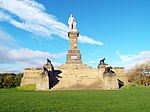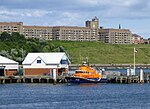Jingling Geordie's Hole
Jingling Geordie's Hole is a cave that has inspired a legend in Tynemouth, England. The cave is between King Edward's Bay and Tynemouth Castle. It was originally known as "Jingling Man's Hole", the "Geordie" being a later addition. Jingling Geordie is reputed to have been a 17th-century pirate and smuggler who used the cave as a lookout for incoming ships. This gave him advance opportunity to lie in wait at the nearby Black Middens where he would lure the ships onto the rocks with lanterns placed to look like boats waiting safely at anchor. He would then plunder the strewn cargoes and hide his booty away in a labyrinth of tunnels running beneath the Castle. Legend has it that Jingling Geordie still had fetters fixed around his legs and the chains rattled everywhere he went. Supposedly the jingle can still be heard on some evenings around the castle walls as his ghost stalks the cliffs keeping a watch over the headland.
Excerpt from the Wikipedia article Jingling Geordie's Hole (License: CC BY-SA 3.0, Authors).Jingling Geordie's Hole
River Tyne North Pier, North Tyneside
Geographical coordinates (GPS) Address Website Nearby Places Show on map
Geographical coordinates (GPS)
| Latitude | Longitude |
|---|---|
| N 55.018 ° | E -1.417 ° |
Address
Tynemouth Priory and Castle
River Tyne North Pier
NE30 4BZ North Tyneside
England, United Kingdom
Open on Google Maps









